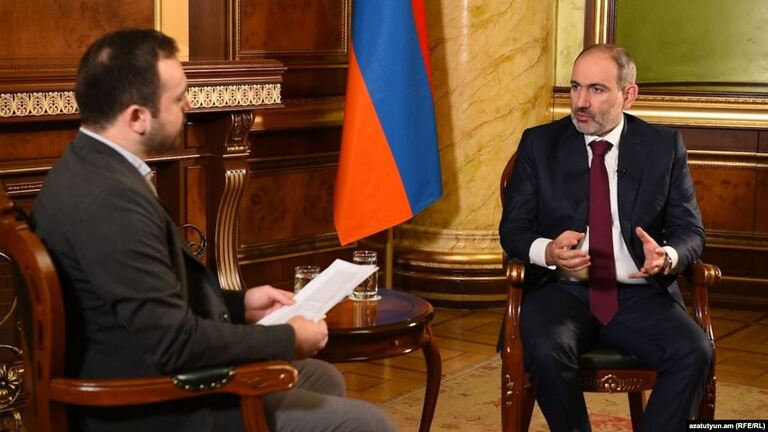5+6 points need to be connected and negotiated in order to find a long-term solution to the Nagorno-Karabakh problem. Armen Grigoryan
In an interview with journalists after the government session on May 5, Secretary of the Security Council Armen Grigoryan said that one of the issues on the agenda of the peace treaty is the recognition of each other’s sovereignty.
“Of course, we note that back in 1992 Armenia and Azerbaijan recognized each other’s sovereign territories and sovereignty within the CIS, however there were other developments in the future, but Armenia and Azerbaijan continue to recognize each other’s territorial integrity.” Touching upon the fact that the Azerbaijani side continues to declare that some territories of Armenia are Azerbaijani, Armen Grigoryan said that such statements don’t contribute to the formation of the peace agenda and work in a calm atmosphere.
“We hope that there will be as few such statements as possible,” he said. According to Grigoryan, Armenia proposed to resolve the Nagorno-Karabakh problem with its six points so that a comprehensive peace treaty could be signed. “At the moment, our approach is that these 2 packages (5-point proposals of Azerbaijan and 6-point proposals of Armenia – ed.) should be connected and negotiations on a peace treaty should begin in order to also find a long-term solution to the Nagorno-Karabakh problem. The priority is to find a solution to the issues of security, protection and rights of our compatriots living in Artsakh, according to which the status of Nagorno-Karabakh should be formed,” Armen Grigoryan said.
Secretary of the Security Council Armen Grigoryan said that there’ve been no discussions between Armenia and Azerbaijan on enclaves. Grigoryan said that the opposition’s claims that there is a danger of possible “transfer of enclaves to Azerbaijan” are unfounded and fake.
“No issue of enclaves was raised so far. We can say that there are enclaves from both sides, and their territories are nearly equal, both sides are silent on this matter and it hasn’t been discussed. Our hope and a possible option for solution is that Armenia leaves the enclave to Azerbaijan, while the Azerbaijani enclaves that are in Armenian territory remain to Armenia. Of course, there is a question on how these were created, and we continue studying this, but the general long-term option is this,” Grigoryan said.
Grigoryan also said that discussions around the bilateral commission on border delimitation between Armenia and Azerbaijan are still ongoing.
“Discussions around this continue. Of course we hoped that it would be possible to find solutions and move forward by the end of April. But I can say that now intensive discussions continue and there is hope that a the meeting could take place soon. The discussions are around the approaches regarding the working group, and there are questions on other matters as well and we haven’t found the final answers to them so far. As soon as we find the answers, there will be a public statement and a meeting will take place,” Grigoryan said.
Referring to the meeting with the Assistant to the President of Azerbaijan Hikmet Hajiyev and a possible meeting between the leaders of Armenia and Azerbaijan Grigoryan said.
“I’ve noted that there are questions, only after answering which we will begin to discuss a possible meeting of the heads of state. We are still continuing discussions, when the discussions reach some stage and a possible meeting is scheduled, there will be a public statement about it,” Armen Grigoryan said.
Foreign Minister of Armenia Ararat Mirzoyan held a discussion at “Atlantic Council” think tank
On May 4, Foreign Minister of Armenia Ararat Mirzoyan, who is in the United States on a working visit, participated as a keynote speaker in a roundtable discussion held at the prestigious US think tank – Atlantic Council.
The Foreign Minister of Armenia touched upon the main agenda and emphases of the working visit to the USA, the Armenia-US Strategic Dialogue, the documents signed during the visit and the prospects of the development of the Armenian-American relations.
Reference was made to the process of reforms aimed at democratic development, protection of human rights, strengthening the rule of law and the fight against corruption.
Ararat Mirzoyan presented the situation around the Nagorno-Karabakh conflict, Armenia’s position on the negotiations on a comprehensive peace agreement with Azerbaijan, and the role of the OSCE Minsk Group Co-Chairmanship in these processes. The humanitarian issues resulting from the 44-day war and need to be urgently addressed were presented. During the meeting reference was also made to the process of normalization of relations between Armenia and Turkey.
Other News
-
Events in Armenia are an internal matter of the country: Peskov, referring to the opposition rallies in Armenia
-
Artur Hovhannisyan: “The Purpose of the Opposition is not to save Artsakh, their purpose is the transition of a power”
-
Alen Simonyan receives Human Rights Defender

